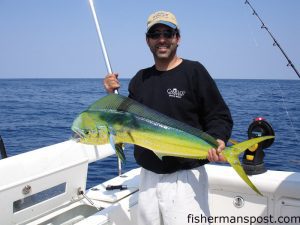Pro Angles – Go Deep For Dolphin

Deep diving plugs like the Rapala X-Rap Magnums add a depth dimension to anglers' trolling spreads and lead to putting more dolphin like the one above in their boats' fish boxes.
From 10 miles off the beach on out to the Gulf Stream, dolphin are one of the most sought-after pelagics off North Carolina’s coast. Hard-fighting, beautifully-hued, and delicious, there’s little doubt as to why the fish are so popular with the North State’s saltwater anglers.
The first few dolphin of the year have shown up in the Gulf Stream from Little River to the Outer Banks, and they’ll be pushing inshore of the Stream over the coming month to the delight of anglers leaving every inlet in the state.
Capt. Chesson O’Briant, of CXC Fishing Charters, is an avowed dolphin addict who takes a three-dimensional approach to his dolphin spread whether trolling the Stream or inside the break.
“Everybody generally just trolls on the surface for dolphin,” he explains, “but unless they’re on a weedline or something else floating, it’s not like they’re cruising around with their fins out of the water all the time.”
The CXC solution? Add a deep-running bait to the trolling spread to tempt bites from fish that aren’t actively feeding on top.
“I used to run wahoo baits behind a big trolling weight a lot,” Chesson continues. “I’d troll dark wahoo colors like red or purple and black, and they caught more dolphin than anything else.”
While he leaves the trolling weights behind now, the captain still likes to keep a deep bait in the spread, most often a deep running plug like those made by Rapala, Bomber, and Yo-Zuri.
Getting deep isn’t the diving plug’s only benefit. When anglers lack a weedline or other surface target and need to find fish, going a little faster than typical ballyhoo speeds is often the ticket.
“You can pull the deep divers pretty quick,” he says, “which is handy for finding some fish.”
When in search mode, anglers can swap out some baitless lures for their ballyhoo on top and pull the plugs below, bump the speed up a bit, and cover some ground to find actively feeding fish.
“I like to run them just back of the prop-wash, swimming about 10’ down,” Chesson says, “and I find that bait gets bit first the majority of the time, especially early in the year.”
Once a fish has committed to the Deep Diver, its schoolmates often follow the hooked fish up to the surface and the more conventional spread swimming up top.
The CXC surface spread is fairly conventional, generally consisting of 4-5 ballyhoo rigged under colorful skirts and a daisy chain with a hook bait behind it on the opposite side of the transom from the deep runner.
In addition to a diving plug, Chesson sometimes augments his spread with an old classic, a Drone spoon behind a planer, to add more even more depth to the spread.
“The Drone gets bit at least as much as the diver,” Chesson reveals, “but dolphin tend to jump and they can throw the hook on that planer/spoon combo easier.”
Whether Drone spoon, diving plug, or both, the deep baits attract attention from more than just dolphin.
“The deep lures double as a bonus fish rig,” the captain adds. “Wahoo, king mackerel, and skipjack and blackfin tunas will jump on a diving plug or the planer bait.”
With boats reporting scattered dolphin along the entire length of the state’s coast this past week, the fish are right on schedule, according to Chesson.
“It typically starts to get good in late-April,” he explains, “and then we start heavy-hitting them in May.”
While the dolphin generally become a bit more spread out as spring wears on to summer, anglers who keep a deep runner in the spread are sure to put a few more dolphin and other pelagics in their fish box all blue water season long.

